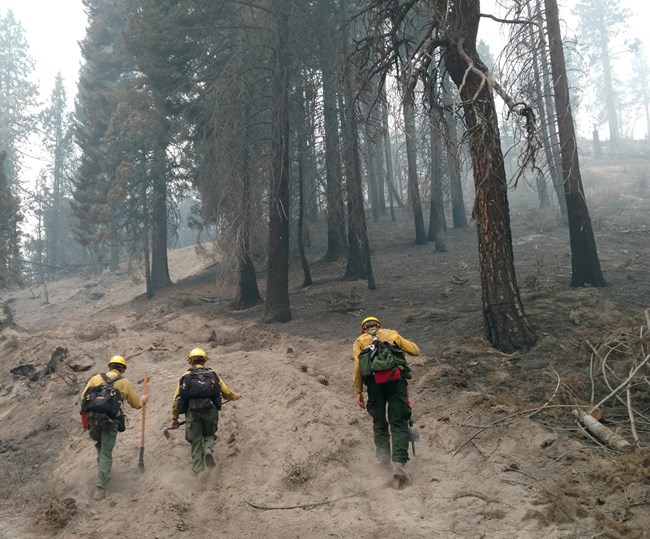
Resource advisors in the field survey a burned area.
NPS photo
NPS wildland fire program treated approximately 200,000 acres this year
“President Trump set aggressive targets to more effectively and actively manage our rangelands and forests to prevent catastrophic wildfires. He took bold action on this issue, which had been missing in previous administrations,” said Secretary David L. Bernhardt. “Answering the call in hitting our significant milestones were our top-class wildland firefighter crews, who have been on the front lines working around the clock to conduct these preventative treatments and extinguish destructive blazes throughout the West this year. They deserve our unending appreciation.”
“The National Park Service has shown impressive dedication to protecting park resources, visitors and local communities from wildfire,” said Margaret Everson, Counselor to the Secretary, exercising the delegated authority of the National Park Service Director. “This year, 24 new firefighters joined the NPS structural fire ranks in national parks, strengthening our ability to respond to fire. In addition, we are proud to have trained more than 450 employees from the Department of the Interior, U.S. Forest Service and state agencies as resource advisors, helping to build a strong fire management support community.”
Guided by Executive Order 13855 – Promoting Active Management of America’s Forests, Rangelands, and Other Federal Lands to Improve Conditions and Reduce Wildfire Risk, as well as Secretary’s Order 3372 – Reducing Wildfire Risks on Department of the Interior Land through Active Management, the NPS has undertaken projects this year to protect people and park resources. These Orders allow Interior agencies to build on existing practices, promote fire-adapted communities, continue safe and effective wildfire response, and create fire resilient landscapes.
Over the last four years, NPS has worked to keep people and park resources safe from unwanted wildfires. Under the direction of the Trump Administration, the NPS wildland fire program has completed prescribed fire treatments on more than 725,820 acres. Prescribed fire treatments, or controlled burns, are an important tool to maintain diverse habitats for plants and animals, help endangered species recover, remove invasive species, and reduce fuels, thereby preventing a destructive fire. Along with efforts to reduce fuels on national park lands, the NPS has reduced risk to over 26,000 structures since 2017. In total, NPS has reduced the risk of catastrophic wildfire to 827,000 acres since 2017. These ongoing efforts not only protect people, ecosystems and structures but also maintain healthy, resilient landscapes.
NPS focused on protecting historic structures, private inholdings and other infrastructure through various methods, including by creating buffer zones to prevent wildfires from reaching structures. In Crater Lake National Park, NPS began a project to reduce fuels on 226 acres of land near areas of high visitor use and historic park structures using hand thinning and pile burning. At Yellowstone National Park, NPS used masticators to treat nearly 280 acres in developed areas and thin additional acres with chainsaws and hand tools. By reducing the risk of wildland fire to these areas, NPS minimizes the impacts to park operations, visitor experiences and gateway communities.
To help communities easily access accurate information about wildfires in their area, NPS worked with partners to build the National Interagency Fire Center (NIFC) ArcGIS Online Organization Open Data site. Using the site, members of the public, media and cooperating agencies can access vital information about the location and size of fires in their areas in real-time.
During 2020, NPS provided in-depth training to equip NPS structural firefighters with the tools they need to prevent the loss of life and property from the adverse effects of structural fires. NPS trained 38 structural fire coordinators, 74 structural firefighters and 16 new driver operators.
NPS efforts to protect communities and resources from the catastrophic effects of wildfire extended to international partners. Last fall, Richard Sinkovitz, Atlantic Zone Fire Management Officer based out of Cumberland Island National Seashore, joined the Andalucía Prescribed Fire Training Exchange. Through the program, Sinkovitz served alongside his Spanish counterpart to carry out the ignitions, holding, and mop up for six prescribed burns in southern Spain, while exchanging strategies and ideas for maintaining effective wildland firefighting programs. Last winter, NPS sent 20 personnel to Australia to support wildland fire suppression efforts during an extreme fire season. NPS fire personnel served alongside Bureau of Land Management, Bureau of Indian Affairs, U.S. Fish and Wildlife Service, U.S. Forest Service and Australian counterparts out of a shared commitment to protect communities and landscapes from devastating wildfires.
Learn more about the NPS wildland fire program: https://www.nps.gov/orgs/1965/index.htm
Source: DOI








